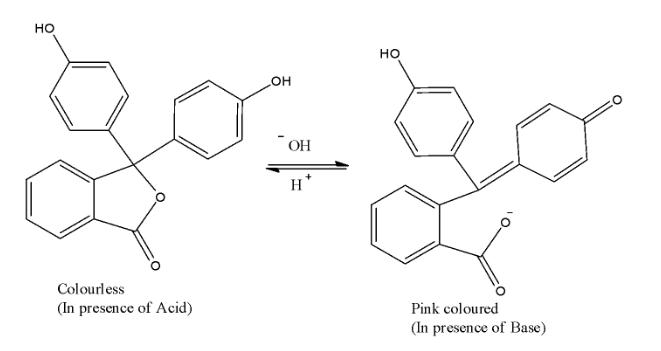
Answer
91.5k+ views
Hint: In the presence of acidic medium, phenolphthalein has a structure that does not impart any colour properties to the solution. The colour of phenolphthalein in basic medium is not a primary colour.
Step by step answer:
First of all, let’s get basic information about phenolphthalein. Phenolphthalein has a formula of ${{C}_{20}}{{H}_{14}}{{O}_{4}}$ . We should know that it is an organic compound of the phthalein family that is widely used as an acid-base indicator.

- The above structure is of phenolphthalein in both acidic medium and in basic medium.
- Phenolphthalein is primarily used as an indicator. It is used as an indicator in acid base titrations. When we add phenolphthalein in aqueous solution, it adopts at least four different states in aqueous solution as a result of pH changes.
- When we add phenolphthalein in acidic solution it exists in protonated form as shown in the reaction providing a colourless solution and when the solution turns basic in nature, the proton gets removed and a salt gets formed. This salt is a coloured one and we can see the solution turning pink due to this.
- So, we can say that phenolphthalein will give pink colour as a basic solution. And in the acidic solution, it will turn colourless.
- Thus, from the above discussion we can say that phenolphthalein will give pink colour in basic solution.
So, the correct option is C.
Note: Remember that in the basic medium, only one proton of phenolphthalein gets removed and results in a salt. So, two protons do not get removed in presence of basic medium even though there are similar two acidic protons are present in the phenolphthalein.
Step by step answer:
First of all, let’s get basic information about phenolphthalein. Phenolphthalein has a formula of ${{C}_{20}}{{H}_{14}}{{O}_{4}}$ . We should know that it is an organic compound of the phthalein family that is widely used as an acid-base indicator.

- The above structure is of phenolphthalein in both acidic medium and in basic medium.
- Phenolphthalein is primarily used as an indicator. It is used as an indicator in acid base titrations. When we add phenolphthalein in aqueous solution, it adopts at least four different states in aqueous solution as a result of pH changes.
- When we add phenolphthalein in acidic solution it exists in protonated form as shown in the reaction providing a colourless solution and when the solution turns basic in nature, the proton gets removed and a salt gets formed. This salt is a coloured one and we can see the solution turning pink due to this.
- So, we can say that phenolphthalein will give pink colour as a basic solution. And in the acidic solution, it will turn colourless.
- Thus, from the above discussion we can say that phenolphthalein will give pink colour in basic solution.
So, the correct option is C.
Note: Remember that in the basic medium, only one proton of phenolphthalein gets removed and results in a salt. So, two protons do not get removed in presence of basic medium even though there are similar two acidic protons are present in the phenolphthalein.
Recently Updated Pages
Name the scale on which the destructive energy of an class 11 physics JEE_Main

Write an article on the need and importance of sports class 10 english JEE_Main

Choose the exact meaning of the given idiomphrase The class 9 english JEE_Main

Choose the one which best expresses the meaning of class 9 english JEE_Main

What does a hydrometer consist of A A cylindrical stem class 9 physics JEE_Main

A motorcyclist of mass m is to negotiate a curve of class 9 physics JEE_Main

Other Pages
Velocity of car at t 0 is u moves with a constant acceleration class 11 physics JEE_Main

Derive an expression for maximum speed of a car on class 11 physics JEE_Main

A soldier with a machine gun falling from an airplane class 11 physics JEE_MAIN

If a wire of resistance R is stretched to double of class 12 physics JEE_Main

The vapour pressure of pure A is 10 torr and at the class 12 chemistry JEE_Main

Electric field due to uniformly charged sphere class 12 physics JEE_Main



